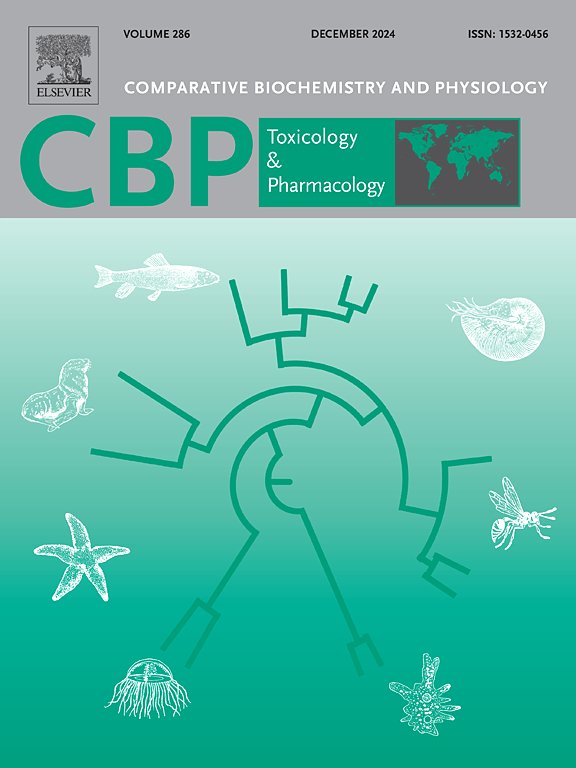Implications of cyantraniliprole sublethal doses on the population dynamics and gene expression of Aphis gossypii Glover (Hemiptera: Aphididae)
IF 3.9
3区 环境科学与生态学
Q2 BIOCHEMISTRY & MOLECULAR BIOLOGY
Comparative Biochemistry and Physiology C-toxicology & Pharmacology
Pub Date : 2024-12-20
DOI:10.1016/j.cbpc.2024.110113
引用次数: 0
Abstract
Cyantraniliprole (CYA), widely recognized as a highly effective solution, is widely used in pest management. It has been broadly utilized to manage diverse pests, among which Aphis gossypii Glover (Hemiptera: Aphididae) is a prominent agricultural pest that leads to significant crop damage worldwide. Studies suggest that the sublethal effect of insecticides might contribute to the resurgence of A. gossypii. Therefore, in this study, A. gossypii were exposed to sublethal doses of CYA (LC15 and LC30 values of 1.43 and 2.93 mg/L, respectively) for 48 h then employed life table parameters and RT-qPCR were used to estimate the sublethal and cross-generational impacts. Treatments with sublethal doses of CYA notably reduced the survival and reproduction of the F0 A. gossypii and CYA at LC30 significantly increased the fecundity and population growth parameters (R0, r, λ, and GRR) of F1 and reduced in the pre-adult stage. Furthermore, gene expression analysis indicated a significant downregulation of juvenile hormone-binding protein (JHBP) in F0. Conversely, the F1 generation exhibited an upregulation of vitellogenin (Vg), insulin receptor substrate 1 (InS1), ecdysone receptor (EcR), and ultraspiracle protein (USP). The funding not only enhance the comprehension of the sublethal effects of CYA on A. gossypii but also provide valuable guidance for the effective utilization of insecticides in managing the pest.

氰甲酰胺亚致死剂量对棉蚜种群动态及基因表达的影响。
氰虫腈(cyantranilprole, CYA)是一种公认的高效药剂,在害虫防治中得到广泛应用。它已被广泛应用于多种害虫的治理,其中棉蚜(Aphis gossypii Glover)(半翅目:蚜虫科)是世界范围内造成重大作物危害的重要农业害虫。研究表明,杀虫剂的亚致死作用可能导致棉蚜的死灰复燃。因此,在本研究中,棉棉铃虫暴露于亚致死剂量CYA (LC15和LC30分别为1.43和2.93 mg/L) 48 h后,采用生命表参数和RT-qPCR方法估计亚致死和跨代影响。亚致死剂量的CYA显著降低了F0A的存活和繁殖。在LC30时,棉皮和CYA显著提高了F1的繁殖力和种群生长参数(R0、r、λ和GRR),并在成虫前期降低。此外,基因表达分析显示F0中少年激素结合蛋白(JHBP)显著下调。相反,F1代表现出卵黄原蛋白(Vg)、胰岛素受体底物1 (InS1)、蜕皮激素受体(EcR)和超囊蛋白(USP)的上调。本研究不仅加深了对CYA对棉蚜亚致死作用的认识,而且为有效利用杀虫剂防治棉蚜提供了有价值的指导。
本文章由计算机程序翻译,如有差异,请以英文原文为准。
求助全文
约1分钟内获得全文
求助全文
来源期刊
CiteScore
7.50
自引率
5.10%
发文量
206
审稿时长
30 days
期刊介绍:
Part C: Toxicology and Pharmacology. This journal is concerned with chemical and drug action at different levels of organization, biotransformation of xenobiotics, mechanisms of toxicity, including reactive oxygen species and carcinogenesis, endocrine disruptors, natural products chemistry, and signal transduction with a molecular approach to these fields.

 求助内容:
求助内容: 应助结果提醒方式:
应助结果提醒方式:


